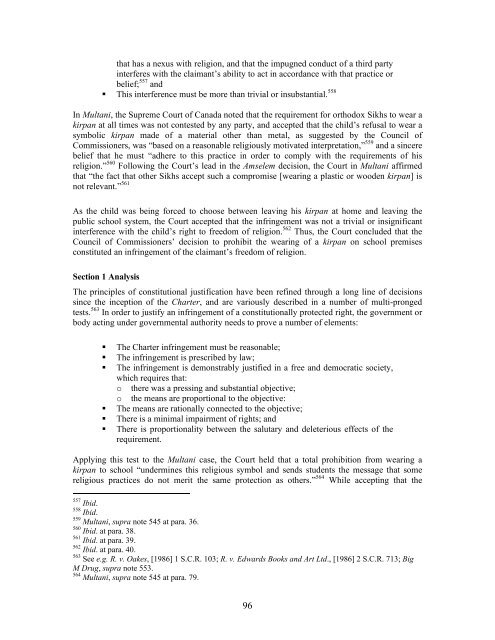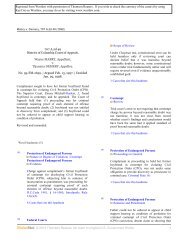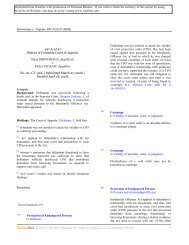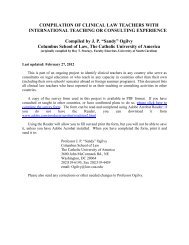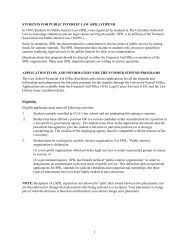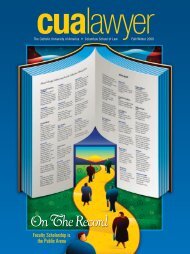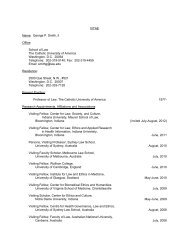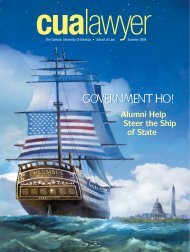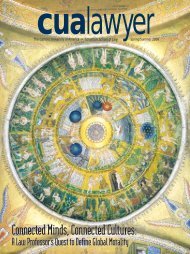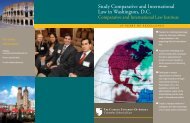Volume IV, Issue II (April 2006) - Columbus School of Law
Volume IV, Issue II (April 2006) - Columbus School of Law
Volume IV, Issue II (April 2006) - Columbus School of Law
Create successful ePaper yourself
Turn your PDF publications into a flip-book with our unique Google optimized e-Paper software.
that has a nexus with religion, and that the impugned conduct <strong>of</strong> a third partyinterferes with the claimant’s ability to act in accordance with that practice orbelief; 557 and This interference must be more than trivial or insubstantial. 558In Multani, the Supreme Court <strong>of</strong> Canada noted that the requirement for orthodox Sikhs to wear akirpan at all times was not contested by any party, and accepted that the child’s refusal to wear asymbolic kirpan made <strong>of</strong> a material other than metal, as suggested by the Council <strong>of</strong>Commissioners, was “based on a reasonable religiously motivated interpretation,” 559 and a sincerebelief that he must “adhere to this practice in order to comply with the requirements <strong>of</strong> hisreligion.” 560 Following the Court’s lead in the Amselem decision, the Court in Multani affirmedthat “the fact that other Sikhs accept such a compromise [wearing a plastic or wooden kirpan] isnot relevant.” 561As the child was being forced to choose between leaving his kirpan at home and leaving thepublic school system, the Court accepted that the infringement was not a trivial or insignificantinterference with the child’s right to freedom <strong>of</strong> religion. 562 Thus, the Court concluded that theCouncil <strong>of</strong> Commissioners’ decision to prohibit the wearing <strong>of</strong> a kirpan on school premisesconstituted an infringement <strong>of</strong> the claimant’s freedom <strong>of</strong> religion.Section 1 AnalysisThe principles <strong>of</strong> constitutional justification have been refined through a long line <strong>of</strong> decisionssince the inception <strong>of</strong> the Charter, and are variously described in a number <strong>of</strong> multi-prongedtests. 563 In order to justify an infringement <strong>of</strong> a constitutionally protected right, the government orbody acting under governmental authority needs to prove a number <strong>of</strong> elements:The Charter infringement must be reasonable;The infringement is prescribed by law;The infringement is demonstrably justified in a free and democratic society,which requires that:o there was a pressing and substantial objective;o the means are proportional to the objective:The means are rationally connected to the objective;There is a minimal impairment <strong>of</strong> rights; andThere is proportionality between the salutary and deleterious effects <strong>of</strong> therequirement.Applying this test to the Multani case, the Court held that a total prohibition from wearing akirpan to school “undermines this religious symbol and sends students the message that somereligious practices do not merit the same protection as others.” 564 While accepting that the557 Ibid.558 Ibid.559 Multani, supra note 545 at para. 36.560 Ibid. at para. 38.561 Ibid. at para. 39.562 Ibid. at para. 40.563 See e.g. R. v. Oakes, [1986] 1 S.C.R. 103; R. v. Edwards Books and Art Ltd., [1986] 2 S.C.R. 713; BigM Drug, supra note 553.564 Multani, supra note 545 at para. 79.96


